
I wasn't expecting much from today, as last night the BBC weather site was showing a dark cloud and two rain drops, with the sun vainly trying to poke out from behind. In the event it was a gloriously sunny day, and the rain only kicked in as I reached St George's Gardens, just a few minutes from King's Cross... for which the technical term is, I believe, a result.
And what a difference the sun made. I've walked across the centre of London quite a few times in the last two-and-a-half months, and each time it has grown slightly less thrilling, purely because the novelty is slowly wearing off. But I really enjoyed today's walk, even though I've already walked through the likes of Piccadilly Circus and Earl's Court, because the weather made it such a pleasure. London in the sun is a beautiful city, and it will take more than familiarity to breed contempt if the summer continues like this.
Barons Court to Earl's Court
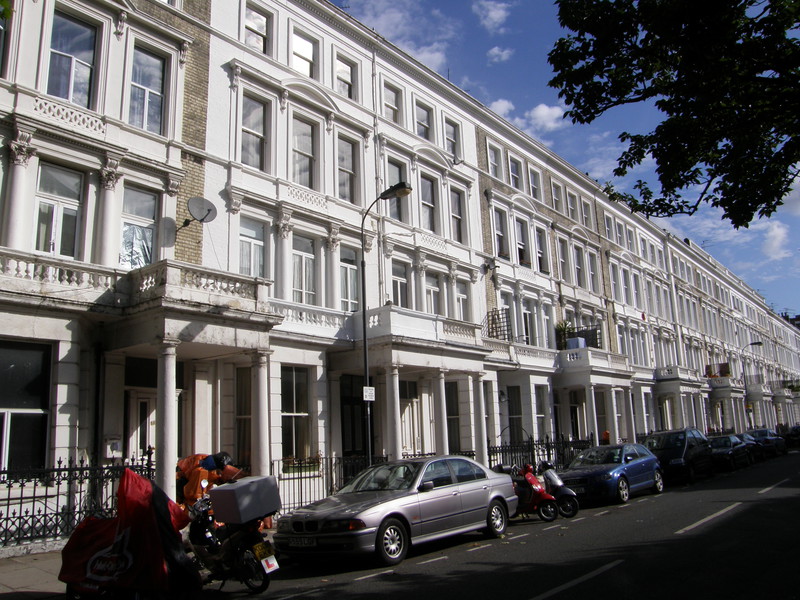
I started the day with the short hop between Barons Court and Earl's Court, as I've already walked from Hammersmith to Barons Court and Earl's Court to South Kensington on the District line. I remember being impressed with the architecture of Barons Court when I last visited, and with the sun shining brightly in a pure blue sky, I fell in love with the area all over again.
This time I headed south from the Tube station in the direction of Normand Park, and I enjoyed every minute of it. All along Vereker Road, side streets shoot off to the left and right, lined with Victorian neo-Georgian terraces, stuccoed townhouses and, every now and then, a modern block of flats, plugging what I can only assume were bomb holes from the Blitz. The modern blocks aren't too bad, hiding from the street behind bushy trees, and down towards Normand Park is a reminder of how much worse things could be, as the view across the park is dominated by large tower blocks. They're not particularly ugly, but they're not Victorian townhouses either, and I know which I prefer.
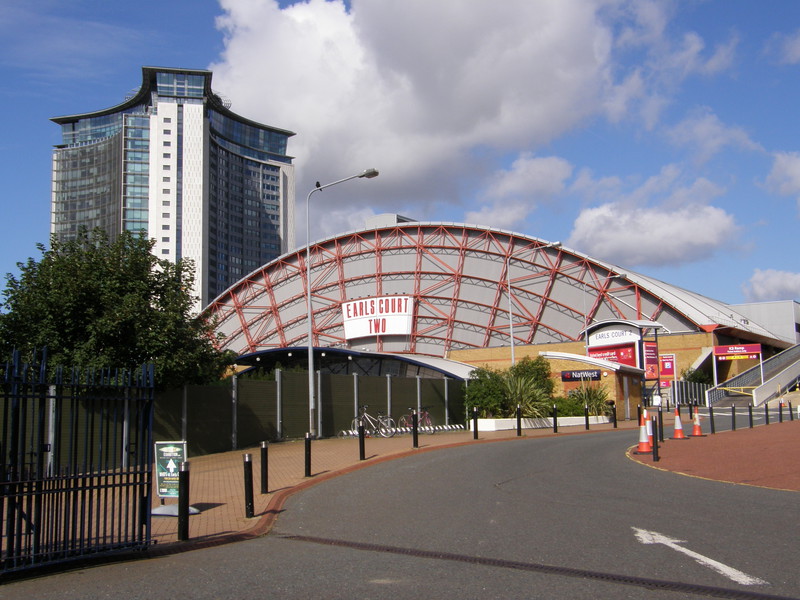
It's worth popping into Normand Park itself, as it is a pleasantly landscaped area with a café and some intriguingly curved street lights. Past the park, back into the traffic on Lillie Road, things get a little busier, and the atmosphere switches from residential to commercial, a change heralded by the huge tower of the Empress State Building. This is the land of exhibitions, with the large Earl's Court Two building on the left, just past the entrance to London Underground's Lillie Bridge Depot (the main civil engineering workshop for the Underground). West Brompton station is on the opposite side of the road – though as it's a District line station, it doesn't form part of this tubewalk – and it's a relief to turn into the quiet crescent of white stucco terraces of Eardley Crescent. The street is lined with hotels, and Earl's Court Exhibition Centre is just round the corner, opposite the Warwick Road entrance to Earl's Court station, which I last visited back on my District line walk from Wimbledon to Edgware Road.
South Kensington to Knightsbridge
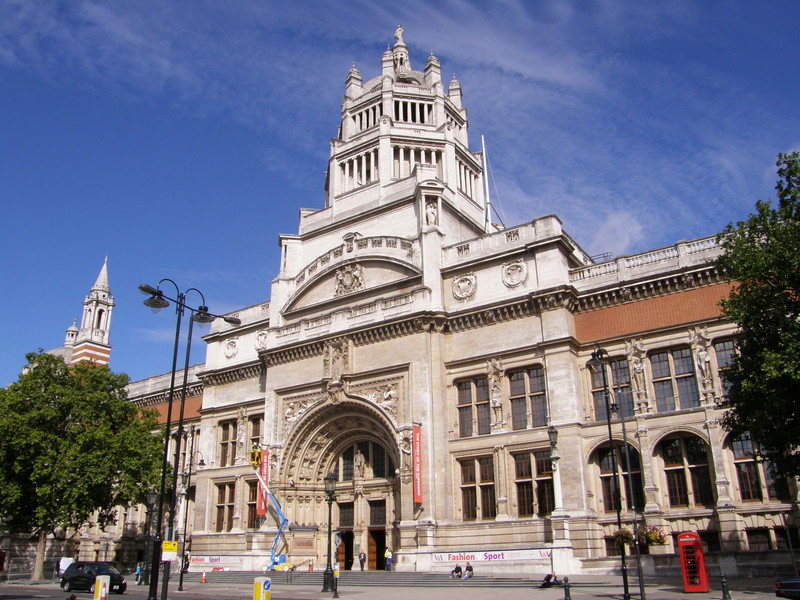
I have a soft spot for South Kensington, as I spent three happy years working at the Victoria and Albert Museum, which is a short stroll up Exhibition Road from the Tube station (or you can take the tunnel under Exhibition Road, which also connects the station to the Natural History Museum and Science Museum). The V&A is the largest museum of decorative arts and design in the world, and although the museum was founded in 1852 and moved to the current location in 1857, the impressive façade along Cromwell Road is actually Edwardian, and was built in red brick and Portland stone between 1899 and 1909. The original Victorian building, which now forms the museum's Henry Cole wing, is a little further north along Exhibition Road.
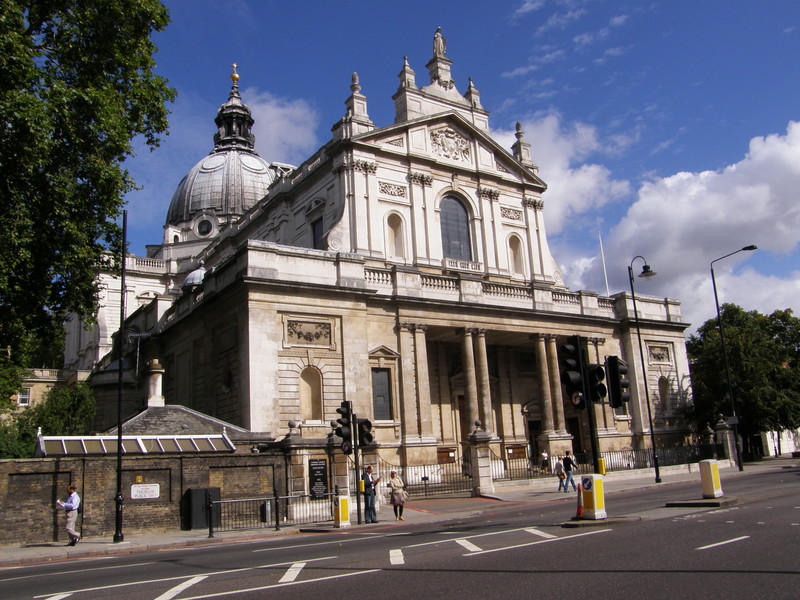
The delights of the V&A are but a taster for this exclusive part of Kensington, and wandering around the backstreets to the east of the museum is an exercise in pretty mews, lovely townhouses, impressive churches and hidden pubs. Before diving into the backstreets, check out the disused Tube station just on the left after the imposing Brompton Oratory; the ox-blood red terracotta building at the junction of Brompton Road and Cottage Place used to be Brompton Road station, which was opened in 1906 as part of the Great Northern, Piccadilly & Brompton Railway (now the Piccadilly line). Brompton Road was between South Kensington and Knightsbridge, but passenger numbers were always low, and when Knightsbridge station was modernised in 1934, Brompton Road was closed, and the building is now used as the town headquarters of the University of London Air Squadron and the University of London Royal Naval Unit.
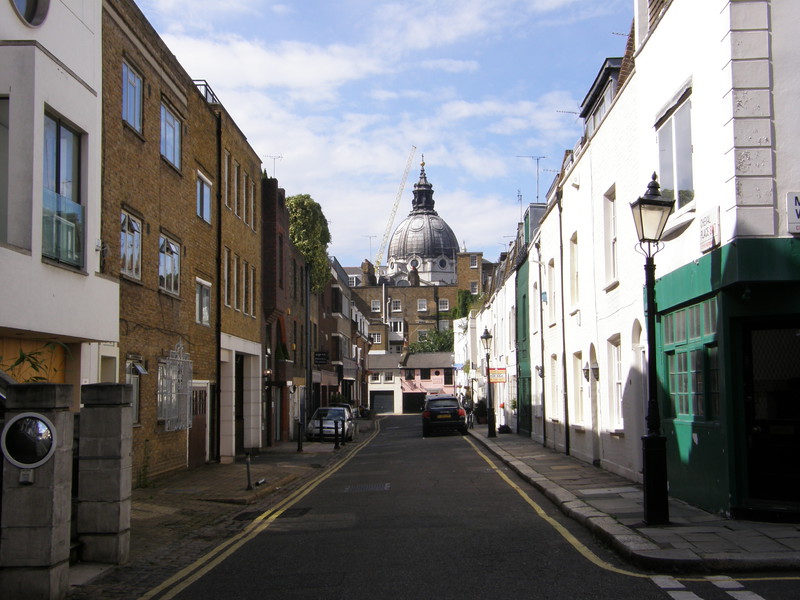
Behind Brompton Oratory is the more modest Holy Trinity Church, which has a small park out the back that is nice and quiet, though in the summer it fills up with museum staff soaking up the rays on their lunch break (and I was one of them – a group of us used to come here every lunchtime, even in the middle of winter, and sit on the same bench every day; routine can be comforting sometimes). The houses along Ennismore Street are to die for, and the pretty residences continue all the way to Cheval Place, which has one of my favourite street views as you look east back to the Oratory. Finally, after turning back down Montpelier Street, you reach the Brompton Road, and there to your left, in the distance, is Harrods, though we'll get a much better and less traffic-strewn view in a moment.
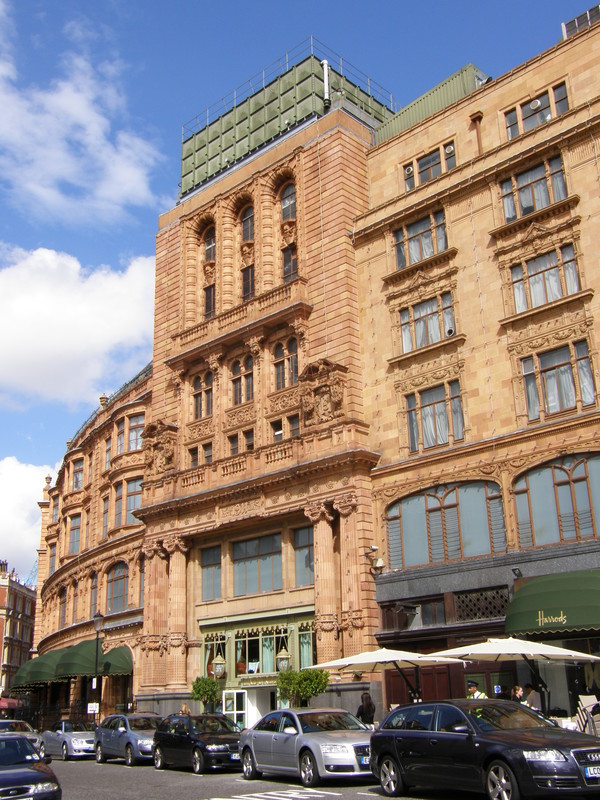
Turning off the main road again, the boutique shops of Beauchamp Place take you away from the traffic and along the backstreets of Walton Place, and there, on the corner with Hans Road, is the back entrance to Harrods, and for the first time it's possible to see just how huge this massive store really is. Harrods is the biggest department store in the world, with over one million square feet of floor space spread over more than 330 departments. It's amazing to think that Harrods actually started in Stepney in east London, where Charles Henry Harrod set up a wholesale grocery in 1834; he moved to the current site in Knightsbridge in 1849, to get away from the unhygienic inner city and to make the most of the 1851 Great Exhibition, which was held in nearby Hyde Park. The current building was built between 1894 and 1905, after a fire destroyed the original building in 1883, and it's a staggering sight.
Knightsbridge station – the only Tube station to have six consecutive consonants in its name – is past the back of Harrods, out on the corner of Brompton Road and Sloane Street. The traffic here is intense and there's currently a lot of building work in the area, so it's difficult to get a good view of the station, particularly as it's a fairly modest affair, with two small entrances opening onto stairs to the station below. This entrance dates from 1934, when escalators were installed and the station was redesigned to cope with the large number of visitors to Harrods; the original 1906 entrance was designed by Leslie Green and was a little further to the west along Brompton Road, though it has since been demolished.
Knightsbridge to Hyde Park Corner
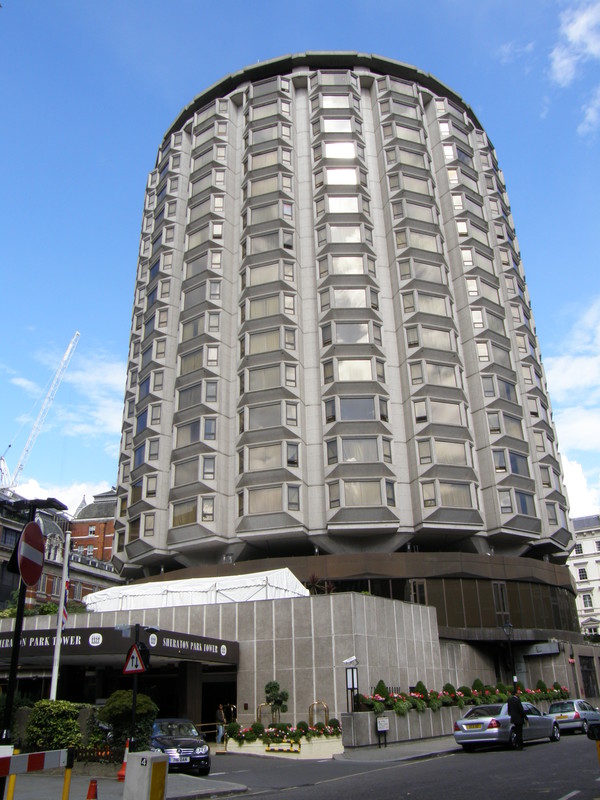
Turning south from the station into Seville Street is a bit of a shock, because standing there like an oversized hair roller is the bizarre tower of the Sheraton Park Tower Hotel. Designed by Richard Seifert, who also designed the Centrepoint tower and Tower 42, it was opened in 1973 and looks like it. I rather like groovy 1970s architecture, and even though the hotel comes as a bit of a surprise after the more traditional architecture of the museums and Harrods, I like surprises, and I think it holds up well after a quarter of a century.
However, the Sheraton doesn't set the theme for the rest of this leg, as this is Belgravia, and Belgravia is anything but modern. There are a couple of curved modern blocks at the bottom of Lowndes Square, but for the most part the square is surrounded by 1840s Victorian neo-Georgian terraces, and there's a delightful (but private) garden in the middle. The square is part of the Cadogan Estate, which stretches from Sloane Square in the south to Lowndes Square in the north, following the line of Sloane Street, and the simple terraced houses built in this area proved very popular.
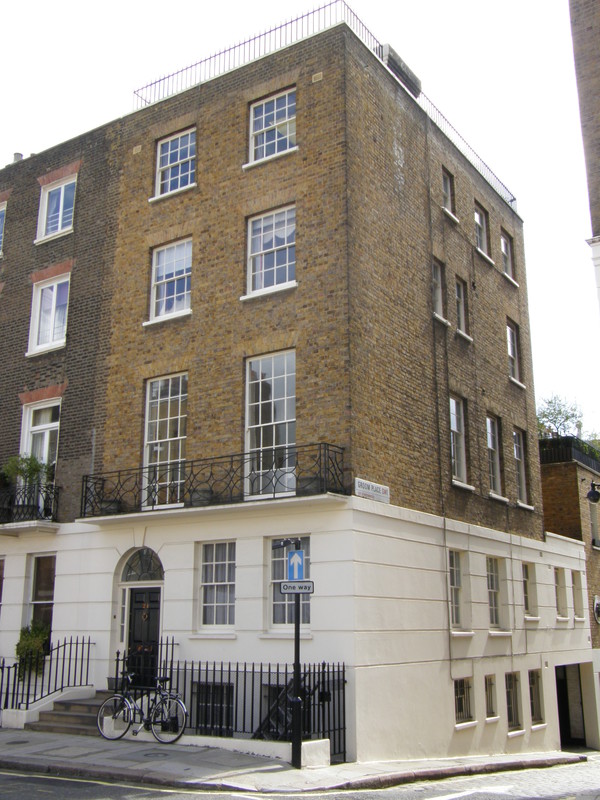
Another big estate in the area was the Grosvenor Estate, which was begun in the 1820s. The Grosvenor family (who later became the Dukes of Westminster), acquired the land in 1677, when it was still marshy farmland and a hang-out for robbers and villains. However, by 1820, the Grosvenors saw the potential for development, and the marshes were drained ready for frenetic development between 1820 and 1835. Belgrave Square, the grand centrepiece of the estate, was established in 1825, and it's a deeply impressive place, with huge stuccoed residential blocks along the sides and a huge private garden in the middle; it's easy to see why this is such a popular spot for embassies, as it has an appropriate air of grandeur while being well out of the price range of mere mortals.
Just off the southeast corner of Belgrave Square is Chapel Street, and number 24 is famous for being the London residence of Brian Epstein, the manager of the Beatles. This is where Epstein lived from , it's where the launch party for Sgt Pepper was held, and it was also where Epstein was found dead on , having taken an accidental overdose of barbiturates.
Hyde Park Corner station is left along Grosvenor Place, on the southeast corner of Hyde Park. The station is fully underground, though the original Leslie Green building still stands on the south side of the road (and it still has its distinctive ox-blood red tiling, despite being a pizza restaurant).
Hyde Park Corner to Green Park

In the middle of the busy traffic of Hyde Park Corner is a small park that's home to Constitution Arch and a statue of the Duke of Wellington, among other attractions, but the best thing about it is the great view you get of the Lanesborough (which lives in the old St George's Hospital building, built between 1827 and 1844; the hospital is now down in Tooting, and the building is now a five-star hotel) and Apsley House (which is also known as Number One, London, as it was the first house passed by travellers once they'd passed the toll gates of Knightsbridge; it was also the former home of the Duke of Wellington).
Heading under the busy A4 via an underpass, there's just time to take in a quick tour of southern Mayfair. Turning past the Hard Rock Café – the world's first, incidentally – the skyline is dominated by the 1963 colossus of the London Hilton on Park Lane Hotel, which stretches 28 storeys into the air. This is where the Beatles first met Maharishi Mahesh Yogi before heading off to India, and it was bombed in 1975 by the Provisional IRA, when two people died and 63 were injured.
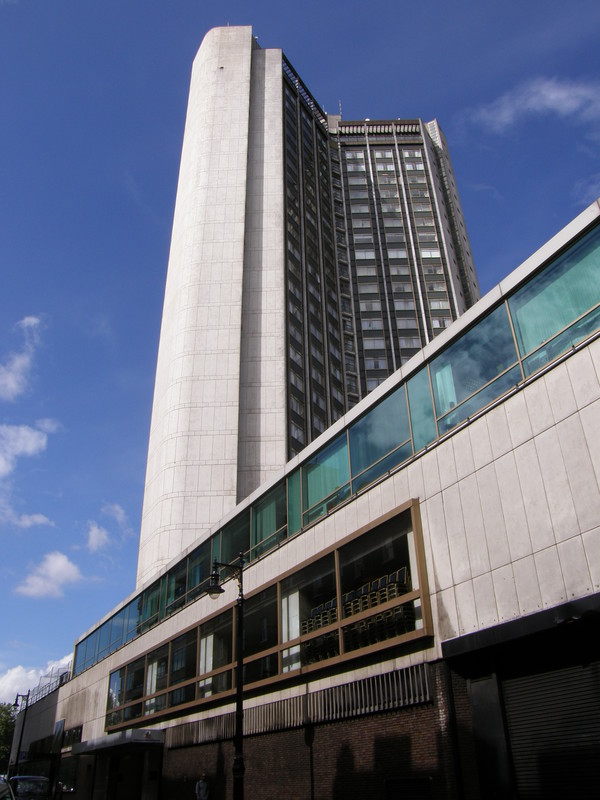
East of the hotel is the somewhat more historic Shepherd Market, a lovely area of shops, squares, restaurants and pubs. The area used to be notorious for prostitution; most famously, Jeffrey Archer met the prostitute Monica Coghlan here in 1986, and in the resulting libel case against the Daily Star, who broke the story, Archer lied in order to win, finally getting his comeuppance in 2001 when he was imprisoned for perjury. These days it's more brasserie than brassiere, and even though it's next to the busy tourist area of Green Park, it's surprisingly undiscovered and has a definite village atmosphere to it. The centre of the area is Shepherd Market itself, a square with a number of pubs that get ridiculously full after work on sunny evenings.
Green Park station is back out on Piccadilly (as the A4 is known round here). The station was originally opened in 1906 under the name Dover Street, as the station buildings were some way to the east, on the corner with Dover Street; in 1933 the station was rebuilt to use escalators, and the current entrances were built on the corner with Stratton Street. The name changed to Green Park at the same time.
Green Park to Piccadilly Circus
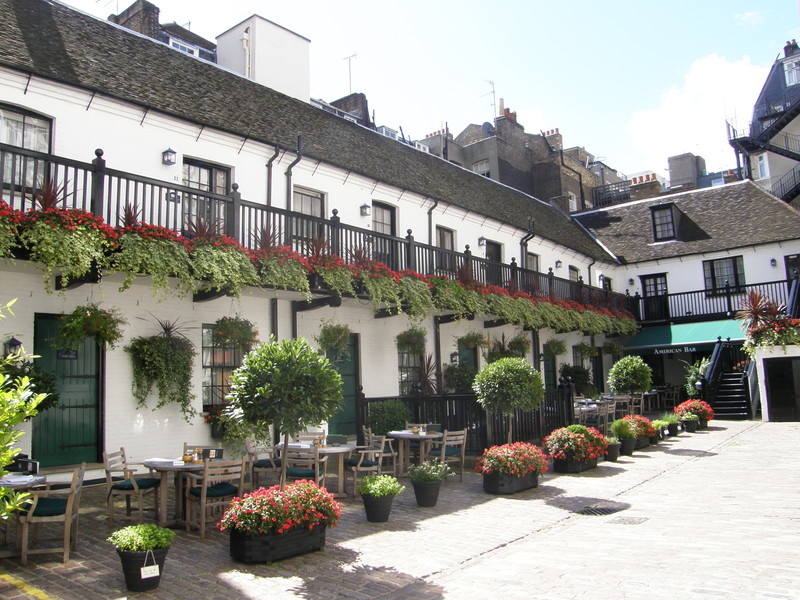
From Green Park to Piccadilly Circus, I followed an excellent walking route through St James's by the doyen of London walking, Andrew Duncan. His route, which can be found in his book Secret London, winds through the tiny passages and backstreets of St James's, and without his help I would never have discovered all the nooks and crannies that make this part of London so fascinating. The route is convoluted and turns back on itself a number of times, but it kicks off in fine style with the lovely Blue Ball Yard, a small cul-de-sac off St James's Street that's home to some stunning 1741 coach houses that are now part of the Stafford Hotel, and whose stables would have housed the horses of the most important people in the country. Apparently one of the cellars below the annexe is a restaurant, and another contains the hotel's 20,000 bottles of wine; perhaps some things don't change, after all.
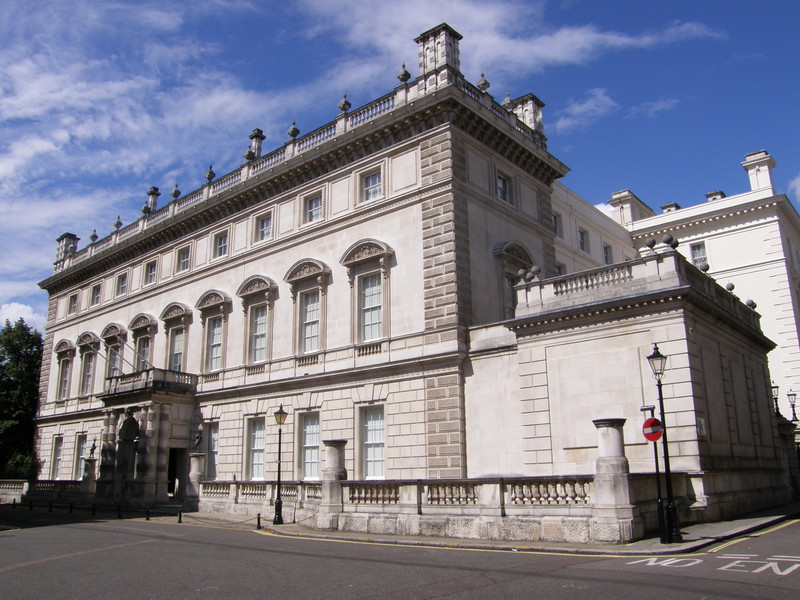
Other highlights along the route include Spencer House (the former townhouse of Princess Diana's family), Bridgewater House (a vast townhouse, built in the mid-19th century for Lord Ellesmere), Russell Court (a small cul-de-sac where you can admire the stained glass windows of the Masonic hall that backs onto it), St James's Palace (the formal base of the Royal Court and the London residence of the Princess Royal and Princess Alexandra), Pickering Place (a cute little courtyard that dates from the 1730s), Crown Passage (a paper-thin passage that's crammed with restaurants, sandwich bars and a pub), and Mason's Yard (a small square that was home to the Indica Bookshop, a focus for the 1960s counter-culture and the place where the underground newspaper International Times was first put together, at number six). The only part of Mr Duncan's excellent route that I didn't think was worth the detour was Babmaes Road, which isn't that thrilling, but that's just splitting hairs; overall I really enjoyed the route, and I refer any interested readers to the detailed descriptions in Secret London, if you want further information.
Piccadilly Circus is not far from Babmaes Road, and Piccadilly Circus station, which I first visited on my Bakerloo line walk from Elephant & Castle to Willesden Junction, lives underneath the road junction, beneath the famous statue of Eros and the pulsating neon and video signs on the northern side of the square. To say that there are lots of tourists here would be an incredible understatement; after the relatively quiet backstreets of St James's, the gloves are well and truly off.
Piccadilly Circus to Leicester Square
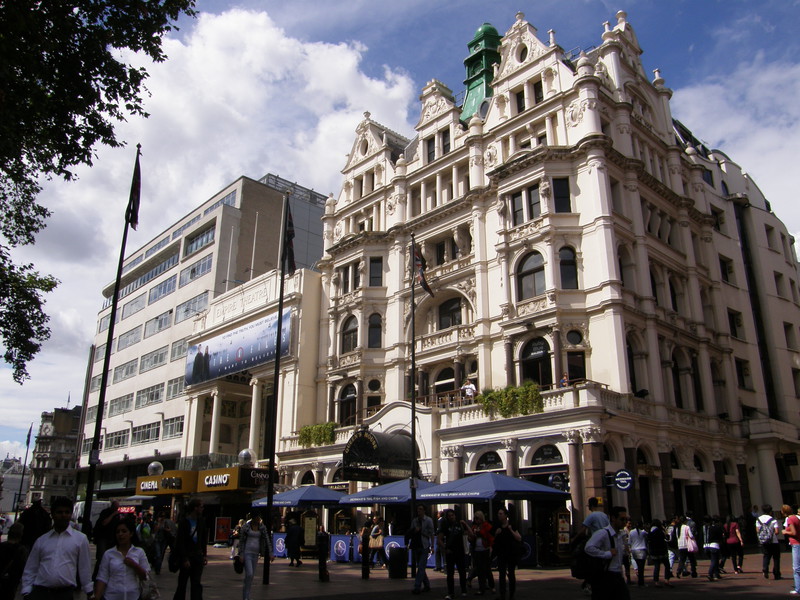
Leicester Square is a short walk from Piccadilly Circus, past the impressive Baroque façade of the London Trocadero. If you thought the circus was busy, then you're in for a shock, as Leicester Square is tourism central... but despite the crowds, I thought it was particularly pleasant. I used to think Leicester Square was rather dingy and full of criminals, but either my memory is a bit hazy, or they've put a lot of effort into clearing things up in the 15 years since I last walked through here and actually bothered to look around me. The central square is smothered with bodies on a sunny day like this, and the cinemas and night-clubs aren't necessarily as attractive in the day as they are at night, but it feels like an entertainment centre, and that's the important thing.
Leicester Square station has a number of entrances. The one on the western side of Charing Cross Road is currently smothered in scaffolding, but there's a Charles Holden-designed Portland stone entrance opposite, and there's even an original Leslie Green station building on Cranbourn Street, with an Angus Steak House occupying the space under the ox-blood red arches.
Leicester Square to Covent Garden
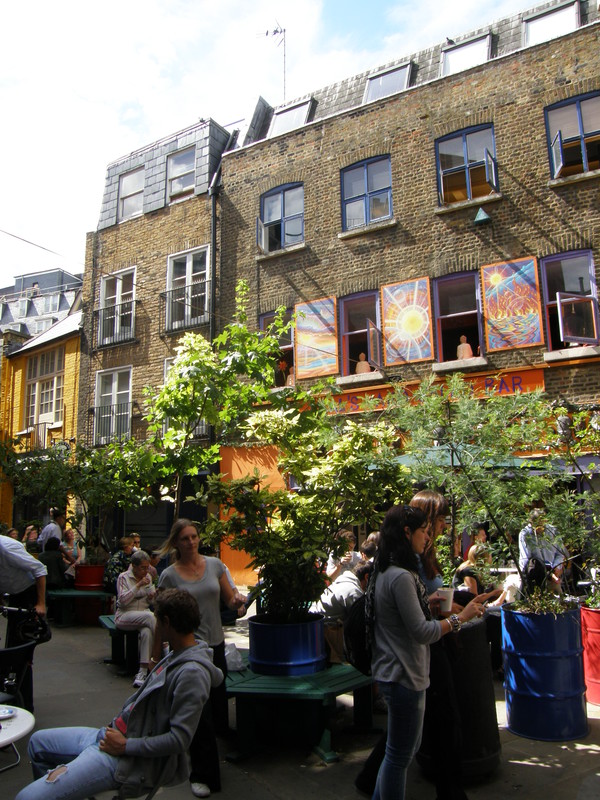
The shortest distance between any two Tube stations is the paltry 0.161 miles between Leicester Square and Covent Garden, but this doesn't stop it being one of the most popular tourist hops on the network. The most direct route is along Long Acre, and it's worth heading this way to take in Stanfords, the best travel and map shop in London (in my humble opinion, anyway; it certainly beats Daunt Books, in which I can never find anything, despite that shop's lovely Edwardian surroundings). Stanfords started in 1852 as the only map seller in London, and the current building was custom built and opened in 1900; it's been modernised since, but it's still the only place to go for travel-related books, and I always pop in here before hitting the road.
The station is a short hop from Stanfords, but it's worth turning left down Mercer Street to the roundabout at Seven Dials, from where it's a short walk down Shorts Gardens to Neal's Yard, a cute and tourist-packed little square that's worth a quick detour. The eclectic shops continue along Neal Street, which pops out on Long Acre opposite Covent Garden station, which was opened on (the line opened some four months earlier on , but Covent Garden station didn't come online immediately). The original Leslie Green terracotta building is still with us, though the arches are topped with a much more modern, red brick affair.
Covent Garden to Holborn
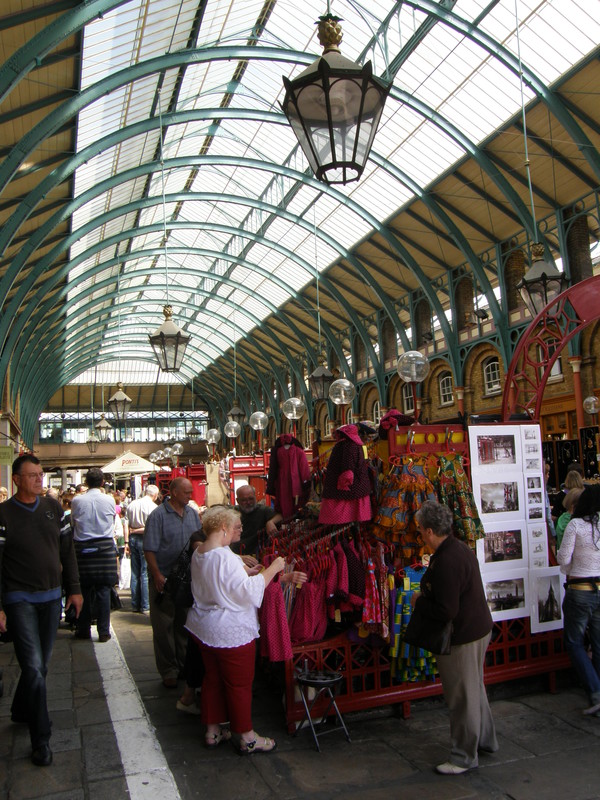
Although it's in the opposite direction to Holborn, it's well worth having a wander round Covent Garden. Home to masses of tourists, street entertainers, shops and the old market, Covent Garden is effectively a tourist-friendly shopping precinct, but it manages to retain the atmosphere of old and doesn't feel remotely tacky. It's easy to see why people flock here, and even on a sunny day like this, with people absolutely everywhere, it's an entertaining place, and the market building in particular is a delight.
On the southeast corner of the square is the London Transport Museum, which is a must-see for anyone interested in the Tube. To the east of the square there are theatres galore, and on Drury Lane is the eccentric Sarastro Restaurant, which has to be seen to be believed: the inside of the restaurant is decorated like the inside of a particularly garish chocolate box, with the dining area split up into ten opera boxes that are based on differing styles.
Turning right along Great Queen Street takes you past the imposing Art Deco building of the Freemasons' Hall, the headquarters of the United Grand Lodge of England and a general meeting place for Masons in the London area. The Masons have been meeting here since 1775, but the current building was built between 1927 and 1933 and is deeply impressive.
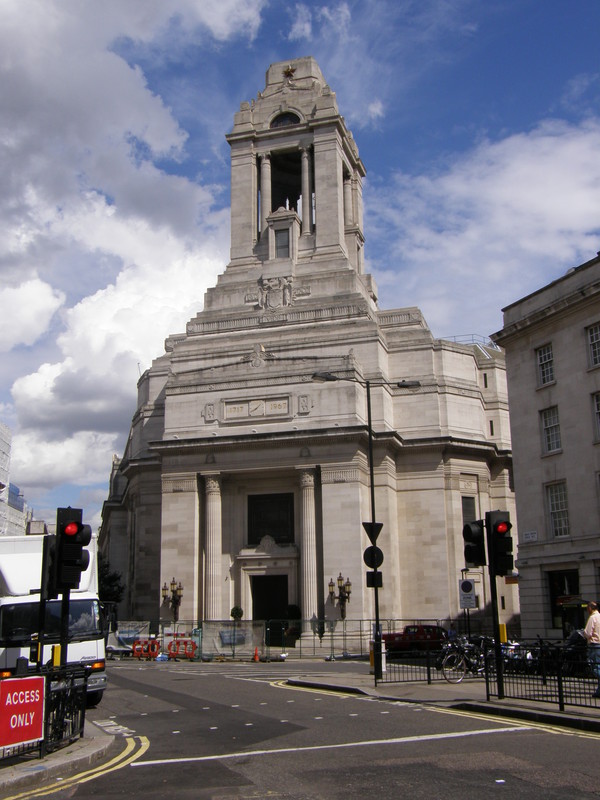
A little further on, Holborn station can be found north along Kingsway, tucked away on the corner with High Holborn. This station was opened as part of the original Piccadilly line in 1906, and it was built on this spot because this is where the line runs above the Central line, which had opened as the Central London Railway back in 1900. However, no connections were initially made between the two lines, not least because the Central London Railway had their own station just 250m away, called British Museum. This was rectified in 1933, when Holborn station was modernised and British Museum station was closed. Interestingly, even though Holborn station was opened as part of the original Piccadilly line, it didn't have red terracotta tiles, as planning regulations imposed by the London County Council forced the designers to use stone for the façade. The front was modernised in 1933 by Charles Holden, when the traditional Leslie Green arches were replaced by large glass windows with the London Underground roundel in the middle, and that's what you can still see today.
Holborn to Russell Square
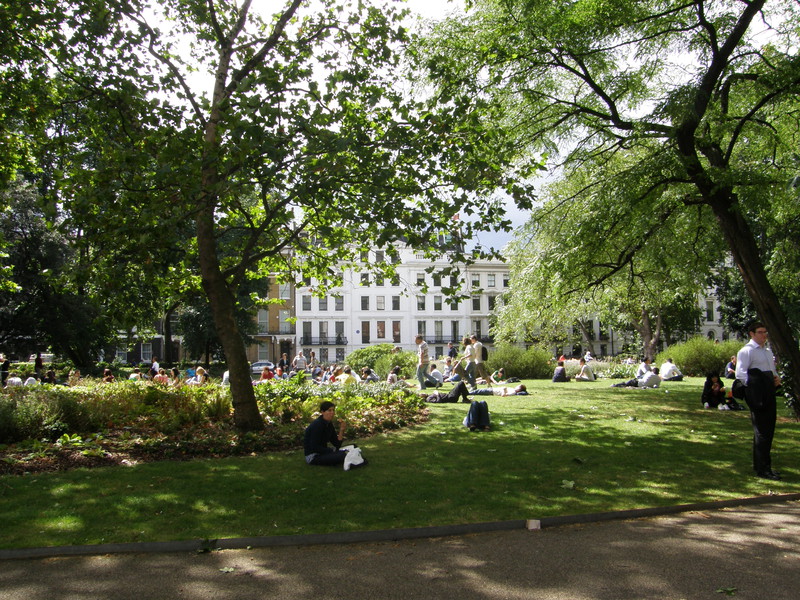
Just north of Holborn is a small pedestrianised shopping street called Sicilian Avenue, which was designed by RJ Worley and opened in 1910. It's still got an Italian feel to it, with its restaurant tables and stone balustrades at each end, and it leads into Bloomsbury Square, which I first brushed against on my Central line walk from Shepherd's Bush to Liverpool Street. The pleasant garden in the middle of the square is open to the public and plenty of people were lounging away as I wandered through, though just as I arrived, the skies started to bruise and suddenly sunbathing didn't look like such a good option after all; that's probably why people started packing while glancing nervously at the sky, rather than it having anything to do with me...
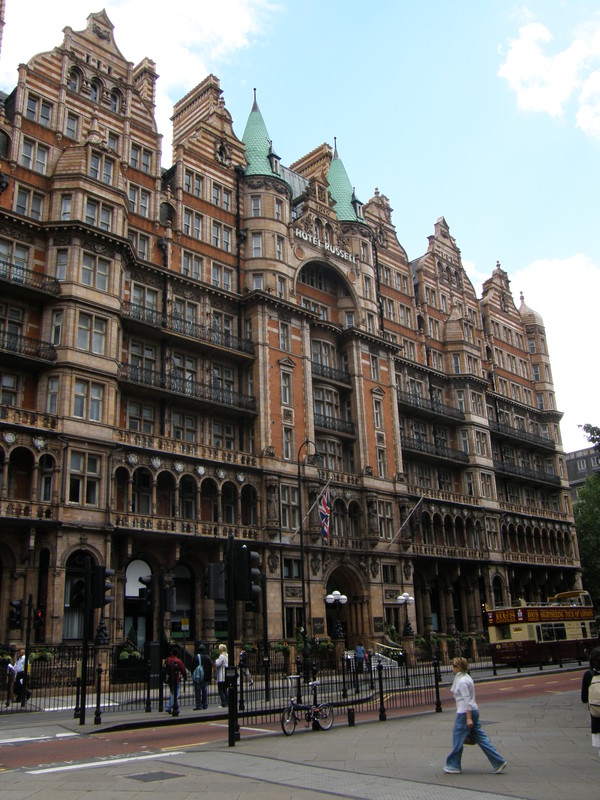
Heading north past the Georgian terraces of Bedford Place takes you to Russell Square, a delightful square with a central garden that's also open to the public. The square was originally laid out by the Duke of Bedford on the site of the gardens of Bedford House, his family home, and the gardens have recently been landscaped to echo the original 19th-century garden that was designed by Humphry Repton. On the eastern edge of the square is the hugely impressive Hotel Russell, built in 1898, though the effect is spoiled somewhat by the dreadful 1960s carbuncle of the Imperial Hotel in the southeast corner of the square. Really, what were they thinking?
Russell Square station is to the northeast of the square, along Bernard Street. It's a very well-preserved example of Leslie Green at his peak, and as it hasn't been built on, it's satisfyingly self-contained. The shops under the arches blend in nicely with the rest of the building, being fronted with windows in dark frames, which makes a nice change from seeing Green's designs spoiled by yet another garish newsagent flogging modern brand names.
Russell Square to King's Cross St Pancras

Opposite Russell Square station is an astounding piece of modern development that completely took me by surprise. The Brunswick Centre was designed by Patrick Hodgkinson in the mid-1960s, and was built between 1967 and 1972. The style is defiantly modernist, and like much of the architecture of the late 1960s, it was widely disliked and soon became a bit faded round the edges (the original building was never painted, as the Council, who had taken over the residential lease in order to use it for social housing, didn't have enough money to paint it). However, in 2002 a much-needed £22 million revamp was kicked off, including painting the blocks in the cream colour that the designers had originally intended, and it's now home to 560 flats, lots of shops and cafés, a Waitrose and the Renoir cinema.
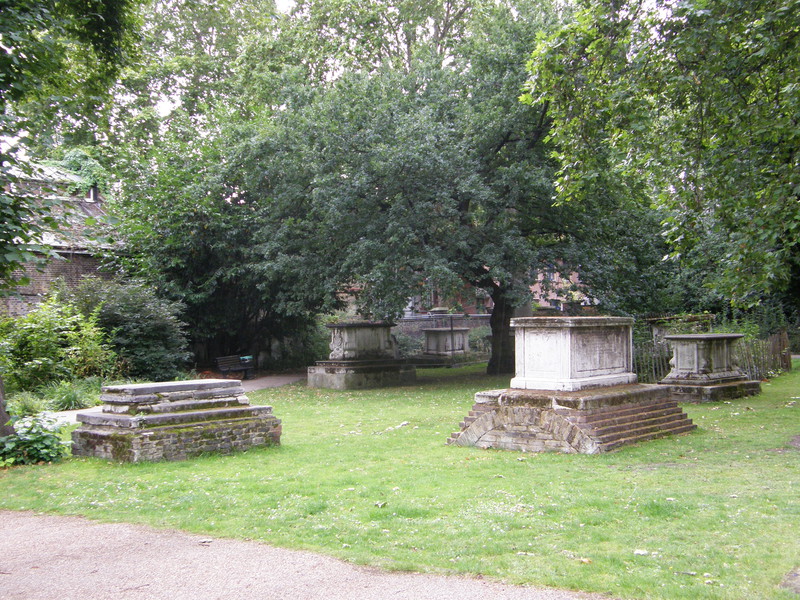
I loved the Brunswick, as it's now known. I'm a great fan of modernist architecture, when it's done properly and looked after well, and I just couldn't stop clicking my camera. I actually thought it might be a completely modern development, it's so clean and shiny, and I fell in love with its clean lines and modernist ethos. It's a shame that at this point the sky started to spit, turning a deeper grey than the concrete of the Brunswick, and I rather hurried my way through the cemetery of St George's Gardens, stopping only to snap some shots of the coffin-shaped tombs that litter the garden.
There is possibly a better route north from St George's Gardens than to follow Grey's Inn Road, but that's where I ended up, and there's not a lot to say about it. Turning back into the backstreets, the Georgian terraces near Argyle Square rub shoulders with some pretty uninspiring tower blocks, and it's a relief to get out onto the main road, opposite the hulking King's Cross St Pancras station. These last few minutes aside, this is a great walk across the centre of London – easily one of the best central-London tubewalks I've done – and the good weather has managed to blow away the bad mood that yesterday's blustering rain brought in. What a relief...